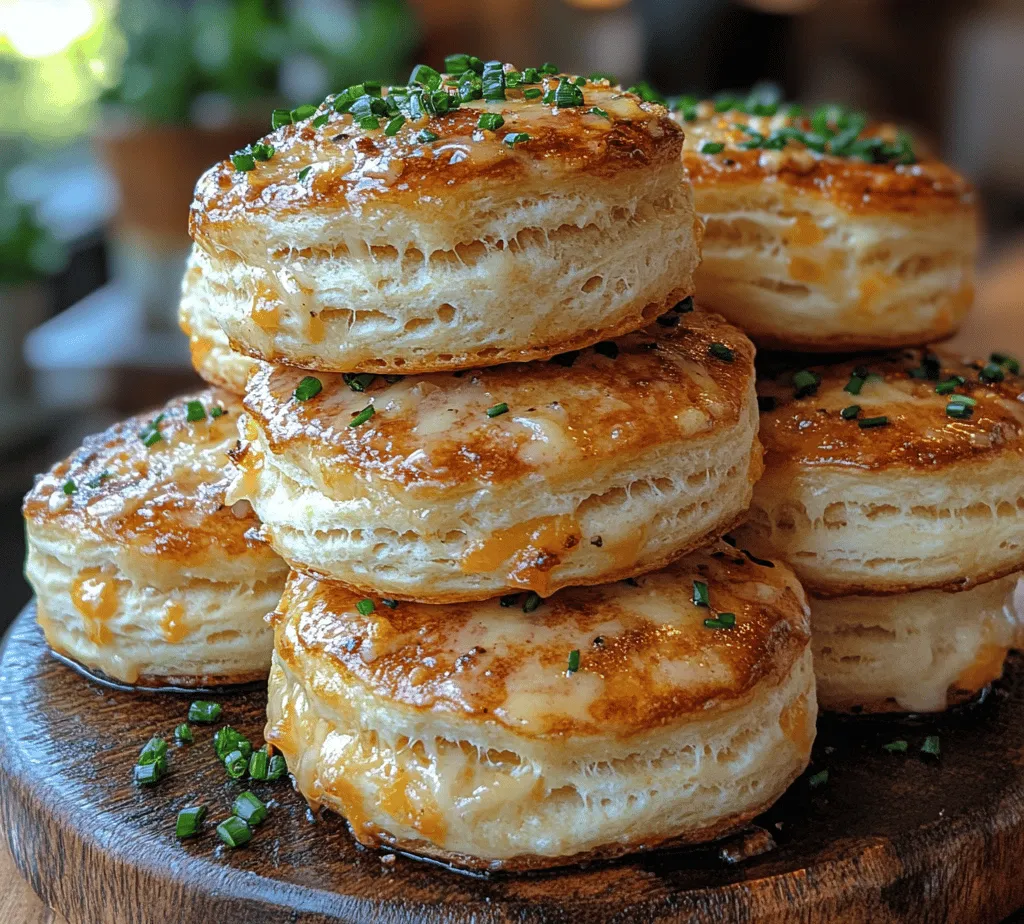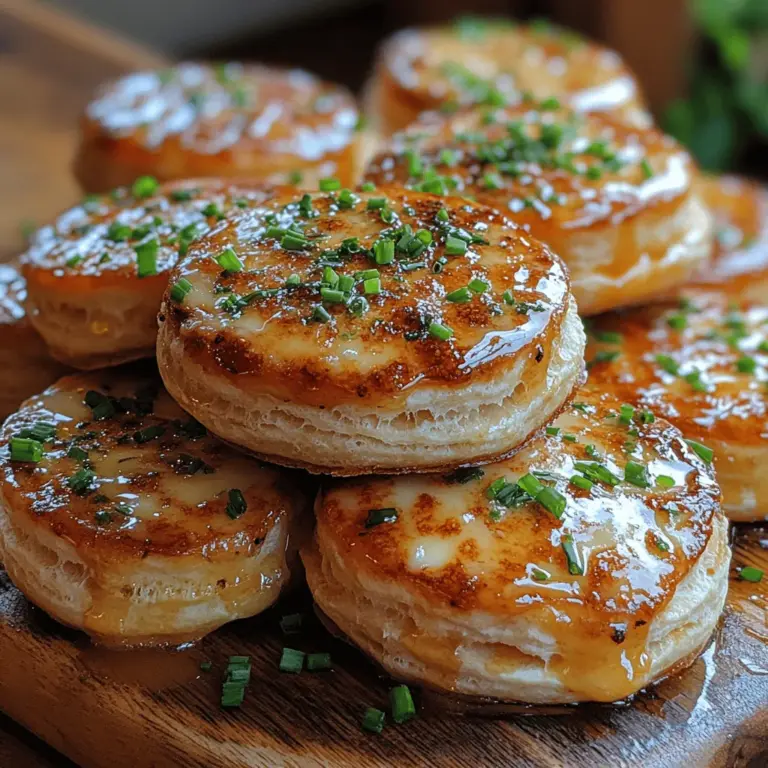Introduction
Biscuits are a quintessential comfort food found in various cuisines around the world. From the fluffy, buttery varieties served at Southern breakfast tables to the flaky, savory versions enjoyed in British tea time, biscuits evoke a sense of warmth and nostalgia. The aroma of freshly baked biscuits wafting through a home creates an inviting atmosphere, making it an ideal comfort food for family gatherings, holiday celebrations, or simple weeknight dinners.
Homemade biscuits stand out not only for their taste but also for the love and care that goes into making them. The process of crafting these delightful baked goods from scratch allows you to control the ingredients, ensuring that every bite is fresh and flavorful. In this article, we will guide you through the steps to create savory and flaky homemade biscuits. You will learn about the essential ingredients, their roles in the biscuit-making process, and detailed instructions to achieve the perfect biscuit every time.
We will delve into the specifics of each ingredient, discuss how they work together to create that beloved flaky texture, and provide you with tips to elevate your biscuit-making game. Whether you’re a seasoned baker or a novice looking to impress, this recipe is adaptable and easy to follow. Let’s get started!
Understanding the Ingredients
To create the perfect savory and flaky biscuits, understanding the role of each ingredient is vital. Here’s a breakdown of the key components that will come together to create your delicious biscuits:
All-Purpose Flour
All-purpose flour is the backbone of any biscuit recipe. It provides the structure and stability needed for the biscuit to rise and hold its shape. When flour is mixed with liquid, its proteins form gluten, which contributes to the biscuit’s texture. The right flour blend will create a light and airy biscuit, while also allowing for a tender crumb.
Choosing high-quality all-purpose flour is crucial; it should be finely milled for the best results. If you prefer a slightly nuttier flavor and added texture, you can consider using whole wheat pastry flour in combination with all-purpose flour.
Baking Powder and Baking Soda
Both baking powder and baking soda are leavening agents that help your biscuits achieve that coveted fluffiness. Baking powder contains both an acid and a base, which means it can create carbon dioxide bubbles that cause the dough to rise when combined with moisture and heat.
Baking soda, on the other hand, requires an acidic ingredient (like buttermilk) to activate it and provide lift. In this recipe, the combination of these two leavening agents ensures that your biscuits will rise beautifully and have a light texture.
Salt
Salt is often overlooked in baking but plays a critical role in enhancing flavors. Just as it does in everyday cooking, salt brings out the natural flavors of the ingredients in your biscuits. It also helps to strengthen the gluten structure, improving the overall texture of the final product. A pinch of salt is essential for balanced flavor, so don’t skip this step.
Garlic Powder (Optional)
If you’re looking to add a unique twist to your biscuits, garlic powder is a fantastic optional ingredient. It infuses the dough with a subtle, savory flavor that pairs wonderfully with cheese and fresh herbs. This ingredient can elevate your biscuits from ordinary to extraordinary, making them a perfect accompaniment to soups or salads. If garlic isn’t your preference, consider substituting it with onion powder or leaving it out altogether.
Cold Unsalted Butter
The importance of using cold butter in biscuit-making cannot be overstated. Cold butter creates steam when baked, which results in the flaky layers that are characteristic of a perfect biscuit. The key is to cut the cold butter into the flour until the mixture resembles coarse crumbs. This technique prevents the butter from melting into the flour before baking, allowing for the creation of those delightful flaky layers.
Using unsalted butter gives you control over the saltiness of your biscuits, allowing you to season them to your taste.
Buttermilk
Buttermilk is another essential ingredient that contributes to the tenderness and flavor of your biscuits. Its acidity reacts with the baking soda, helping to create a lighter texture. The tangy flavor of buttermilk also adds depth to the biscuits, making them more complex and enjoyable.
If you don’t have buttermilk on hand, you can easily create a substitute by mixing one cup of milk with one tablespoon of vinegar or lemon juice. Let this mixture sit for about 5-10 minutes to sour before using it in your recipe.
Fresh Chives and Cheese
To amp up the flavor of your biscuits, adding fresh chives and cheese is a delightful choice. Fresh chives bring a mild onion flavor that complements the buttery richness of the biscuits perfectly. Cheese, whether sharp cheddar, mozzarella, or even a crumbly feta, adds a savory richness that makes these biscuits irresistible.
If you’d like to experiment with different flavors, consider using herbs like rosemary, thyme, or even sun-dried tomatoes for a Mediterranean twist.
Preparation Steps for Perfect Biscuits
Now that you understand the ingredients and their roles in the biscuit-making process, let’s dive into the preparation steps. Following these instructions carefully will ensure that your homemade biscuits turn out perfectly every time.
Preheat the Oven and Prepare the Baking Sheet
The first step in making your savory and flaky biscuits is to preheat your oven to 425°F (220°C). A hot oven is crucial for achieving a good rise and flaky texture, so don’t skip this step. While the oven is preheating, line a baking sheet with parchment paper to prevent sticking and ensure even baking.
Mixing Dry Ingredients
In a large mixing bowl, combine the all-purpose flour, baking powder, baking soda, salt, and garlic powder (if using). Whisk these dry ingredients together thoroughly to ensure that the leavening agents are evenly distributed. This step is essential for achieving consistent results throughout your biscuits.
Cutting Butter into Flour
Next, it’s time to cut the cold unsalted butter into the flour mixture. Using a pastry cutter, fork, or even your hands, work the cold butter into the flour until the mixture resembles coarse crumbs with pea-sized pieces of butter. This technique is critical for creating those flaky layers.
Be careful not to overwork the dough; the goal is to have small chunks of cold butter throughout the mixture. These chunks will create steam as the biscuits bake, resulting in a light and flaky texture.
Adding Buttermilk
Once your butter is incorporated, it’s time to add the buttermilk. Create a well in the center of your dry ingredients and pour in the cold buttermilk. Using a spatula or wooden spoon, gently stir the mixture until just combined. Be careful not to overmix; the dough should be slightly shaggy.
If you’re adding fresh chives and cheese, fold them in at this stage, ensuring they are evenly distributed throughout the dough. This will enhance the flavor and texture of your biscuits.
Shaping the Dough
After mixing, transfer the dough onto a lightly floured surface. Gently pat the dough into a rectangle about 1-inch thick. Avoid rolling the dough, as this can develop gluten and toughen the biscuits. Instead, use your hands to shape it gently.
Once shaped, fold the dough over itself a couple of times. This folding technique will help create layers, which are crucial for achieving the desired flakiness in your biscuits. After folding, pat the dough down again to the desired thickness.
Cutting the Biscuits
Using a sharp biscuit cutter or a glass, cut out your biscuits, making sure to press straight down without twisting to keep the layers intact. Place the cut biscuits onto your prepared baking sheet, leaving some space between each one to allow for expansion during baking.
Baking the Biscuits
Once your biscuits are cut and placed on the baking sheet, it’s time to bake them. Slide the baking sheet into the preheated oven and bake for about 12-15 minutes, or until the biscuits are golden brown on top. Keep an eye on them during the last few minutes of baking to prevent over-browning.
The result will be a batch of perfectly flaky, savory biscuits that are sure to impress.
Stay tuned for the next part of our article, where we will discuss tips for the best results, variations to try, and answer some common questions about biscuit-making!

Incorporating Herbs and Cheese: Creative Ways to Customize Biscuits
One of the delightful aspects of baking homemade biscuits is the opportunity to infuse them with various flavors. By incorporating herbs and cheese, you can elevate your biscuits from simple to spectacular. Fresh herbs like rosemary, thyme, or chives can add a fragrant touch, while grated cheeses such as cheddar, parmesan, or even feta can introduce a savory richness.
To customize your biscuits, consider adding about 1/4 to 1/2 cup of finely chopped herbs or shredded cheese to your dry ingredients before mixing in the wet components. This ensures even distribution and enhances the overall flavor profile of the biscuits. For a Mediterranean twist, try combining feta cheese with chopped olives and a sprinkle of oregano. Alternatively, for a classic American flavor, mix in shredded sharp cheddar and fresh chives. The possibilities are endless, and experimenting with different combinations can lead to exciting new favorites.
The Significance of Not Overmixing Dough for Optimal Texture
Achieving the perfect biscuit texture is an art that hinges on the simple principle of not overmixing the dough. When you mix the dough, gluten strands begin to develop, which can lead to tough, chewy biscuits instead of the desired flaky, tender results.
To avoid this, mix your wet and dry ingredients until they are just combined. It’s normal for the dough to be a bit shaggy with some flour streaks still visible. This gentle handling allows the butter to remain in small chunks, which will create steam during baking and result in those delightful flaky layers. Remember, the goal is to keep the dough as light and airy as possible, so embrace a light touch during this crucial step.
Techniques for Folding and Rolling Dough to Create Flaky Layers
Once your dough is mixed, the next step is to create those coveted layers that make homemade biscuits so irresistible. The folding and rolling technique is key. After turning the dough onto a lightly floured surface, pat it into a rectangle about 1-inch thick.
To create layers, fold the dough over itself in thirds like a letter, then gently roll it out again into a rectangle. Repeat this process two to three times, being careful not to overwork the dough. Each fold will help create more layers, which will puff up beautifully in the oven. This technique is paramount for achieving that tender, flaky texture that will have everyone coming back for seconds.
Baking the Biscuits
Importance of Temperature and Baking Time for Achieving the Perfect Golden Brown Finish
When it comes to baking biscuits, the oven temperature and timing are crucial. Preheat your oven to 425°F (220°C) to ensure a quick rise and a golden brown finish. The high heat causes the butter to melt rapidly, creating steam that lifts the biscuits and results in a flaky texture.
Place the biscuits on a baking sheet lined with parchment paper, making sure to space them at least an inch apart to allow for expansion. Bake for approximately 12-15 minutes or until they are beautifully golden on top. Keep a close eye as they bake; every oven is different, and you want to catch them at just the right moment for the best results.
How to Recognize When Biscuits Are Properly Baked: Visual Cues and Internal Texture
Understanding how to tell when your biscuits are done can take some practice, but there are clear signs to look for. Visually, the tops should be a rich golden brown, and the sides should appear slightly crispy. You can also gently tap the top of a biscuit; a hollow sound indicates that they are baked through.
For an internal texture check, you can break one open. The inside should be light and fluffy, with no raw or doughy spots. If they still seem wet or undercooked, return them to the oven for a few more minutes but keep a close eye to avoid overbaking.
Optional Finishing Touches: Brushing with Butter for Added Flavor and Sheen
For an extra touch of indulgence, consider brushing the tops of your freshly baked biscuits with melted butter as soon as they come out of the oven. This not only adds a lovely sheen but also enhances the flavor, making the biscuits even more irresistible. You can also sprinkle a little sea salt on top for a delightful salty contrast that pairs perfectly with the buttery goodness of the biscuit.
Serving Suggestions
Highlighting Various Ways to Enjoy Homemade Biscuits
Homemade biscuits can be enjoyed in countless ways, making them a versatile addition to any meal. Serve them warm as a side dish with dinner, or enjoy them as part of a hearty breakfast. Their flaky texture pairs well with a variety of toppings, elevating any meal they accompany.
Suggested Accompaniments: Butter, Honey, Jams, or Savory Spreads
When it comes to serving, the classic butter and jam combination is a favorite, but don’t hesitate to get creative. A drizzle of honey adds a touch of sweetness that beautifully complements the buttery flavor. For a savory treat, consider serving biscuits with a spread of cream cheese or a homemade herb-infused butter.
You could also create a rustic charcuterie board featuring your biscuits alongside artisanal cheeses, cured meats, and seasonal fruits for a delightful appetizer or brunch offering.
Creative Serving Ideas: Pairing with Soups, Salads, or as a Breakfast Item
Beyond spreads, biscuits can play a starring role in your meals. They are perfect for pairing with hearty soups and stews, acting as the ideal vessel for scooping up savory broths. Alternatively, serve them alongside a fresh garden salad or as a sandwich base. Cut a biscuit in half and fill it with scrambled eggs and crispy bacon for a delightful breakfast sandwich that will kickstart your day.
Storage and Reheating
Best Practices for Storing Leftover Biscuits to Maintain Freshness
If you find yourself with leftover biscuits (though they’re often devoured quickly), store them properly to maintain their freshness. Allow the biscuits to cool completely before placing them in an airtight container. You can also wrap them in plastic wrap and then place them in a zip-top bag to prevent moisture from making them soggy.
For optimal freshness, consume the biscuits within 2-3 days. If you need to keep them longer, consider freezing them. Wrap each biscuit individually in plastic wrap, then place them in a freezer-safe bag. They can last for up to three months in the freezer.
Methods for Reheating Biscuits to Restore Their Flaky Texture
When it’s time to enjoy your leftover biscuits, reheating them correctly is essential to restore their original flakiness. Preheat your oven to 350°F (175°C) and place the biscuits on a baking sheet. Heat for about 10-15 minutes, or until warmed through. If you want to revive the outer crust, consider wrapping them in aluminum foil for the first half of the reheating process, then removing the foil for the last few minutes to crisp them up.
For quicker reheating, you can microwave the biscuits in short 15-second intervals, but be cautious—this method can lead to a chewier texture.
Nutritional Information
A Brief Overview of the Nutritional Aspects of Homemade Biscuits
Homemade biscuits can be a delightful treat, but understanding their nutritional aspects is important for a balanced diet. A standard biscuit typically contains around 150-200 calories, depending on the ingredients used. They provide carbohydrates primarily, which serve as a quick energy source, along with a modest amount of fats from the butter.
Discussion on Ingredients Substitutions for Healthier Alternatives
For those looking to make healthier versions of biscuits, several ingredient substitutions can be made. Consider using whole wheat flour instead of all-purpose flour for added fiber and nutrients. For a gluten-free option, almond flour or a gluten-free baking mix can be excellent alternatives.
If you want to reduce calories or fat, try replacing half of the butter with unsweetened applesauce or Greek yogurt. You can also experiment with low-fat cheese in savory biscuits or reduce the sugar in sweet variants. These adjustments can help you enjoy delicious biscuits while being mindful of your dietary needs.
Conclusion
Baking homemade biscuits is a joyful experience that fills your kitchen with warmth and delightful aromas. Their versatility allows for endless customization, whether you choose to incorporate herbs, cheese, or delightful spreads. With a few simple techniques, you can master the art of biscuit making, ensuring they are flaky, tender, and golden brown every time.
We encourage you to experiment with the recipe and share your unique creations with friends and family. The joy of homemade biscuits is not just in the eating but in the sharing and enjoyment of your culinary efforts. So gather your ingredients, roll up your sleeves, and embark on a delicious journey of biscuit baking. Your kitchen—and your taste buds—will thank you.

